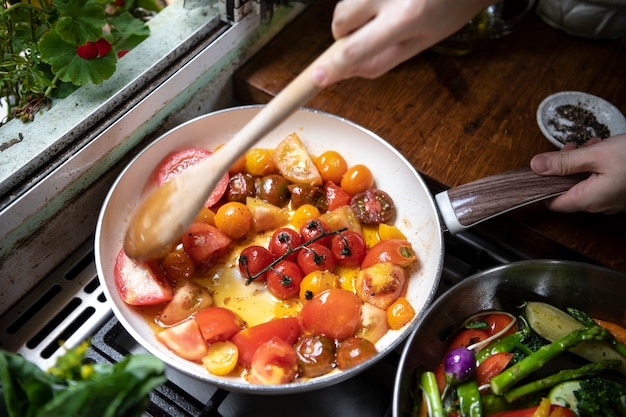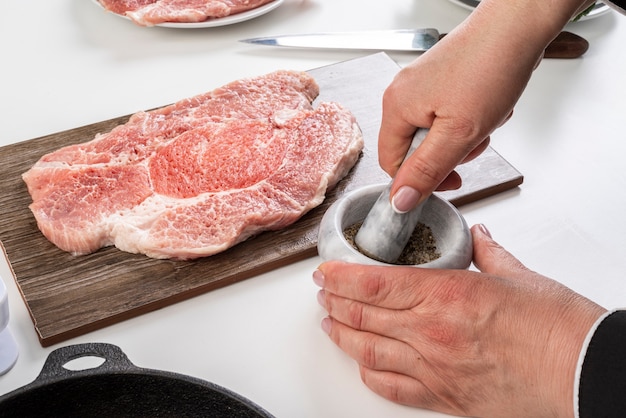The alluring sizzle of a steak hitting a scorching pan, the intoxicating aroma of browning meat filling the kitchen – it's a symphony for the senses that promises pure culinary delight. And when you nail it, that first bite, juicy and tender, is a moment of pure bliss. Over the years, I've spent countless hours in the kitchen, experimenting with different techniques, trying to master the art of the perfect pan-seared steak. It's been a journey, filled with both triumphant successes and cringeworthy mishaps – dry, tough, and frankly, inedible steaks. But with each attempt, I learned, adapted, and refined my approach, eventually cracking the code to consistently producing a steak worthy of a Michelin-star restaurant. So, grab your favourite cut of meat, put on your apron, and join me on this delicious adventure!
(Part 1) The Foundation: Choosing Your Steak

The first step, and arguably the most important, is selecting the right steak – the foundation upon which your culinary masterpiece will be built. This is where your personal preferences come into play. I confess, I'm a sucker for a good ribeye – its thick marbling translates into incredible juiciness and flavour. But if you're after something leaner, perhaps a sirloin or a strip is more your style. The key here is to choose a cut that's at least an inch thick – that's essential for achieving a beautiful sear and a tender, juicy interior.
The Thickness Factor
It's not just the cut, but the thickness that matters. That one-inch rule is a good guideline. If it's thinner, it'll cook too quickly, leaving you with a tough, dry piece of meat. But if it's thicker than an inch and a half, it might take longer to cook through, demanding careful attention to prevent overcooking the outside while ensuring the middle is cooked to your liking.
The Beauty of Marbling
And then there's marbling. Let's be clear, marbling isn't just about aesthetics. It's the intramuscular fat that gives your steak that beautiful marbled look and contributes significantly to its flavour and tenderness. The more marbling, the more juicy and flavorful your steak will be. However, if you prefer a leaner steak, opt for a cut with less marbling.
Understanding Different Cuts
Let's delve into some popular steak cuts and their characteristics:
- Ribeye: Renowned for its rich flavour and marbling, often resulting in a juicy and tender steak.
- new york strip: Known for its leaner profile and slightly more pronounced flavour compared to ribeye.
- Sirloin: Offers a balance of flavour and tenderness, often a good choice for those seeking a leaner cut.
- filet mignon: The most tender cut, known for its delicate flavour and melt-in-your-mouth texture.
(Part 2) The Prep: Getting Your Steak Ready

You've got your chosen steak, now it's time to prepare it for its starring role. These steps might seem simple, but they make a world of difference in the final outcome.
Bringing It to Room Temperature
First things first, take your steak out of the fridge and let it sit at room temperature for about 30 minutes. This crucial step ensures even cooking. A cold steak takes longer to cook through, and you might end up with a cold, raw centre.
Patting It Dry
Next, give your steak a good pat dry with paper towels. This removes excess moisture, allowing for a crisp sear and preventing the steak from steaming instead of searing.
Seasoning Perfection
Now, it's time to season. Keep it simple, salt and pepper are all you really need. I prefer to season liberally on both sides, making sure to get the edges as well. Some chefs swear by other seasonings, but I'm a purist when it comes to this classic duo.
(Part 3) The Sizzle: Mastering the Pan-Sear

You're almost there! It's time to put your steak in the spotlight – the pan!
The Right Pan: Your Culinary Ally
You want a heavy-bottomed pan, like a cast iron pan or a stainless steel pan. These pans distribute heat evenly, crucial for achieving that beautiful, even sear.
Get That Pan Hot: The Key to a Perfect Crust
Heat the pan over high heat until it's smoking hot. This is crucial! A hot pan creates that amazing sear, locking in the juices and giving you that delicious, crispy crust.
Oil Choice: Enhancing Flavour
Once the pan is super hot, add a tablespoon or two of oil. I like to use a neutral oil like canola or grapeseed oil – they have a high smoke point and won't interfere with the flavour of your steak. You don't want your oil smoking, just shimmering.
The Moment of Truth: Searing Your Steak
Now, the moment of truth. Carefully place your steak in the pan. You should hear a satisfying sizzle as it hits the hot oil. Resist the urge to move it around too much. Let it cook undisturbed for about 2-3 minutes per side.
(Part 4) The Flip: Turning Your Steak
Time to turn your steak. It's tempting to keep flipping, but resist!
Patience is Key: Achieving Perfect Doneness
Flip your steak once it's developed a nice crust. You can tell by the color – it should be a beautiful golden brown. This should be around 2-3 minutes per side. You should also be able to lift the steak from the pan easily, without it sticking. If it sticks, give it a bit more time.
Cooking to Your Liking: Mastering Doneness
Keep cooking the steak for the desired doneness, about 2-3 minutes per side for medium-rare, 3-4 minutes for medium, and 4-5 minutes for medium-well.
(Part 5) The Rest: Giving Your Steak a Break
Once your steak is cooked to your liking, take it out of the pan and place it on a cutting board. Let it rest for 5-10 minutes. This allows the juices to redistribute throughout the steak, resulting in a more tender and flavorful cut.
(Part 6) The Sauce: Adding a Finishing Touch
While your steak is resting, you can prepare a sauce to take your dish to the next level. I like to keep things simple with a classic pan sauce.
Pan Sauce Essentials: A Simple Deglaze
Here's how: Deglaze the pan with a little bit of wine, broth, or even water, scraping up all the delicious bits that are stuck to the bottom. Add some butter and herbs for a richer flavour. You can also add a little bit of lemon juice or balsamic vinegar for extra zing.
Beyond the Basics: Elevating Your Sauce
For a more complex pan sauce, experiment with different ingredients:
- Mushroom Sauce: Use a splash of red wine and chopped mushrooms for a rich and earthy sauce.
- Garlic Herb Sauce: Add garlic, thyme, and rosemary to the pan for a fragrant and aromatic sauce.
- Peppercorn Sauce: Combine black peppercorns, brandy, and butter for a spicy and robust sauce.
- Béarnaise Sauce: Whip up a classic Béarnaise sauce with egg yolks, butter, and tarragon for a luxurious finish.
(Part 7) The Presentation: Plate It Up
Your steak has rested, your sauce is simmering, it's time to plate it up!
A Culinary Masterpiece: Slicing for Tenderness
Slice your steak against the grain, which means cutting perpendicular to the muscle fibers. This will help to make it more tender and ensure each bite melts in your mouth.
Garnish for the Win: Adding Visual Appeal
Garnish with fresh herbs, a sprinkle of sea salt, or a drizzle of olive oil.
(Part 8) The Enjoyment: Savoring the Flavors
And finally, the moment you've been waiting for - enjoying your perfectly pan-seared steak.
A Feast for the Senses: Taking a Bite
Take a bite and savour the flavors. The juicy, tender meat, the crisp sear, the delicious sauce. It's a culinary masterpiece, and you did it!
FAQs
1. What's the Best Cut of Steak for Pan-Searing?
The best cut of steak for pan-searing depends on your preference, but some popular choices include ribeye, New York strip, sirloin, and filet mignon. Each cut offers a unique flavour profile and texture.
2. How Do I Know When My Steak is Cooked to My Liking?
There are several ways to determine the doneness of your steak:
- Touch Test: Press the steak with your finger. It should feel similar to your finger when you press it. For rare, it should be soft; medium-rare, slightly springy; medium, firm; medium-well, firmer; and well-done, very firm.
- internal temperature: Use a meat thermometer to check the internal temperature. A rare steak should reach 125-130°F, medium-rare 130-135°F, medium 135-140°F, medium-well 140-145°F, and well-done 145-150°F.
- Color: Rare steak has a deep red center, medium-rare has a pink center, medium has a light pink center, medium-well has a slight pink center, and well-done has a brown center.
3. Can I Use a Cast Iron Pan?
Absolutely! Cast iron pans are excellent for searing steaks as they retain heat very well and distribute it evenly. They also add a touch of rustic charm to your culinary creation.
4. Should I Season the Steak Before Cooking?
Yes, seasoning the steak before cooking is important. Salt helps to draw out moisture and create a flavorful crust. It's also a good idea to season liberally, making sure to coat both sides and the edges of the steak.
5. Can I cook steak in the Oven After Pan-Searing?
Yes, you can finish cooking your steak in the oven after pan-searing. This helps to ensure that the steak is cooked evenly throughout, especially for thicker cuts. Simply preheat your oven to 350°F (175°C) and place the pan-seared steak in the oven for 5-10 minutes, depending on the thickness and desired doneness.
(Part 9) Beyond the Basics: Exploring Variations
Now that you've mastered the basic pan-searing technique, let's explore some variations to spice things up and add a touch of creativity to your culinary repertoire.
Adding Flavour with Herbs: Aromatic Delights
For a herby twist, try adding fresh rosemary, thyme, or sage to the pan after searing the steak. These herbs infuse the steak with a delightful aroma and complement its rich flavor. You can even create a compound butter by combining softened butter with your favourite herbs and garlic, then spreading it over the steak before serving.
A Citrusy Kick: Bright and Refreshing
Love a bit of citrus? Add a squeeze of lemon juice or orange juice to the pan sauce for a bright and refreshing flavour. The acidity of citrus cuts through the richness of the steak and adds a vibrant touch to your dish.
Spicy Surprise: A Touch of Heat
For a fiery finish, try adding chili flakes or a pinch of cayenne pepper to the pan sauce. This adds a subtle kick of heat that complements the savory flavour of the steak.
A Touch of Sweetness: Balancing the Flavors
If you're feeling adventurous, try deglazing the pan with a splash of balsamic vinegar or honey for a touch of sweetness. This creates a sweet and savory sauce that balances the richness of the steak.
(Part 10) The Ultimate Guide to Pan-Seared Steak: A Table for Reference
Here’s a table to summarise all the key points for pan-searing a perfect steak, and to help you create a flavourful masterpiece in your own kitchen:
| Step | Instructions | Notes |
|---|---|---|
| 1. Choosing the Steak | Select a cut of steak that is at least one inch thick, such as ribeye, New York strip, or sirloin. Consider the marbling level based on your preference for tenderness and flavour. | Ribeye offers rich flavour and juiciness, while leaner cuts like sirloin are better for those seeking less fat content. |
| 2. Preparing the Steak | Bring the steak to room temperature for 30 minutes. Pat it dry with paper towels. Season liberally with salt and pepper. | Room temperature steak cooks evenly. Patting dry ensures a crisp sear. Salt draws out moisture and creates a crust. |
| 3. Heating the Pan | Heat a heavy-bottomed pan over high heat until it is smoking hot. Add a tablespoon or two of oil, like canola or grapeseed oil. | High heat creates the perfect sear, locking in juices and creating a delicious crust. Neutral oils work best for searing. |
| 4. Searing the Steak | Place the steak in the hot pan and sear for 2-3 minutes per side without disturbing it. | Don't overcrowd the pan to ensure even cooking. Let the steak develop a crust before flipping. |
| 5. Flipping the Steak | Carefully flip the steak once it has developed a crust. Continue cooking for 2-3 minutes per side for medium-rare, 3-4 minutes for medium, and 4-5 minutes for medium-well. | Patience is key! Adjust cooking time based on your desired level of doneness. |
| 6. Resting the Steak | Remove the steak from the pan and place it on a cutting board. Let it rest for 5-10 minutes. | Resting allows the juices to redistribute, resulting in a more tender and flavorful steak. |
| 7. Preparing the Sauce (Optional) | Deglaze the pan with a little bit of wine, broth, or water, scraping up the flavorful bits. Add butter and herbs for richness. | Pan sauces are a delicious way to enhance the flavour of your steak. Get creative with herbs and spices. |
| 8. Presenting the Steak | Slice the steak against the grain and arrange it on a plate. Drizzle with the pan sauce and garnish with fresh herbs or a sprinkle of salt. | Slicing against the grain makes the steak more tender. Garnishing adds visual appeal and enhances the flavour profile. |
| 9. Enjoying the Steak | Take a bite and savour the juicy, tender meat, the crisp sear, and the delicious sauce. | Enjoy the culinary masterpiece you have created! |
(Part 11) The Journey Continues: Learning with Every Steak
And that, my friends, is how you achieve a perfect pan-seared steak. But remember, it's a journey, not a destination. Every steak you cook will be a new experience, a chance to refine your technique, to experiment with flavours, and to create something truly special. So, don't be afraid to try new things, to push your boundaries, and to always strive for that perfect sear, that juicy bite, that taste of pure satisfaction. Happy cooking! And remember, even the most seasoned chefs started somewhere. So, embrace the process, learn from each attempt, and most importantly, enjoy the journey of becoming a master pan-searing chef!
Everyone is watching

Corn on the Cob: The Ultimate Guide to Perfectly Cooked Ears
Healthy MealsAh, corn on the cob. Just the name evokes images of sunny days, barbecues, and that sweet, juicy flavour that ...

Scallops: The Ultimate Guide to Perfect Cooking
Healthy MealsAh, scallops. Those delicate, sweet, and utterly delicious morsels of the sea. They hold a special place in my...

Spaghetti Squash: The Ultimate Guide to Cooking and Serving
Healthy MealsRemember that time you saw spaghetti squash at the supermarket, looking all bumpy and strange, and thought, "W...

Salmon Cooking Times: Perfect Guide for Every Recipe
Healthy MealsLet me tell you, cooking salmon is an art form. It's all about getting that perfect balance: juicy and tender,...

Ham Cooking Time: How Long to Bake, Smoke, or Boil a Delicious Ham
Healthy MealsAh, ham. It's a classic, isn't it? A real crowd-pleaser, especially around holidays. And when done right, it'...
